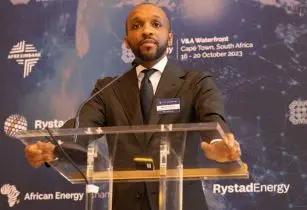Exploration, associated services and energy transition opportunities in Senegal were unpacked at the Invest in African Energy Reception in London – organised by the African Energy Chamber – during a presentation from Mamadou Fall Kane, deputy permanent secretary of COS Petrogaz, titled, First Gas: Senegal’s Energy Future
Created in 2016, COS Petrogaz serves to define, implement and monitor the country’s hydrocarbon sector strategy, with a view to ensuring the successful development of its oil and gas projects.
Senegal holds substantial oil and natural gas reserves – estimated at 1.03 bn barrels and 910 bn cu/m, respectively – along with high potential for renewable energy and a geostrategic location on Africa’s western coastline. With megaprojects including the Sangomar Field Development, Greater Tortue Ahmeyim Liquefied Natural Gas and the Yakaar-Teranga Development set to come online between now and 2025, the presentation identified opportunities across the entire value chain of these projects for oil and gas field services, including drilling contracts, production and maintenance.“The quality of Senegal gas meets all expectations. In addition, this time next year, Senegal will become an oil producer, producing 100,000 barrels of oil from the Woodside-operated Sangomar project,” noted Fall Kane.
Additional upstream opportunities include 12 blocks currently open for licensing and located around the existing Rufisque Offshore Profond (ROP) and Ultra Deep Offshore (UDO) exploration activities, available for block acquisition, farm-in, surveying, seismic data acquisition and interpretation, civil works and related subcontracting. For both major and junior explorers alike, Senegal offers a long history of exploration, a wealth of geological and seismic data of its basins, an attractive fiscal framework and a stable national oil company, Petrosen, leading the sector.
“Next year, our growth rate is expected to be 10%, which is to say there is a significant transformation in the country. This is the time to invest,” Fall Kane stated.
The presentation also showcased Senegal’s gas-to-power strategy, which aims to provide reliable and affordable energy, specifically through the first phase of Yakaar-Teranga that will supply gas for power generation to the domestic market. Investment opportunities within Senegal’s natural gas value chain include the construction of gas infrastructure, conversion of oil power plants, construction of new gas-fired power plants and ancillary activities. Through the exploration and monetisation of its gas reserves, Senegal hopes to establish itself as a petrochemical and mining hub, with the West African nation also home to between 500 mn and one billion tons of phosphates reserves and 630 mn tons of proven iron ore reserves.
In terms of the energy transition, Senegal holds significant solar (>240 MW per km2), wind (>350 MW per sq km) and hydropower potential (>1,400 MW). By harnessing its renewable resources, Senegal also carries the potential to become a major producer and exporter of hydrogen and low-carbon ammonia, generating green solutions in agriculture, chemicals, maritime transport and the production of sustainable steel.




